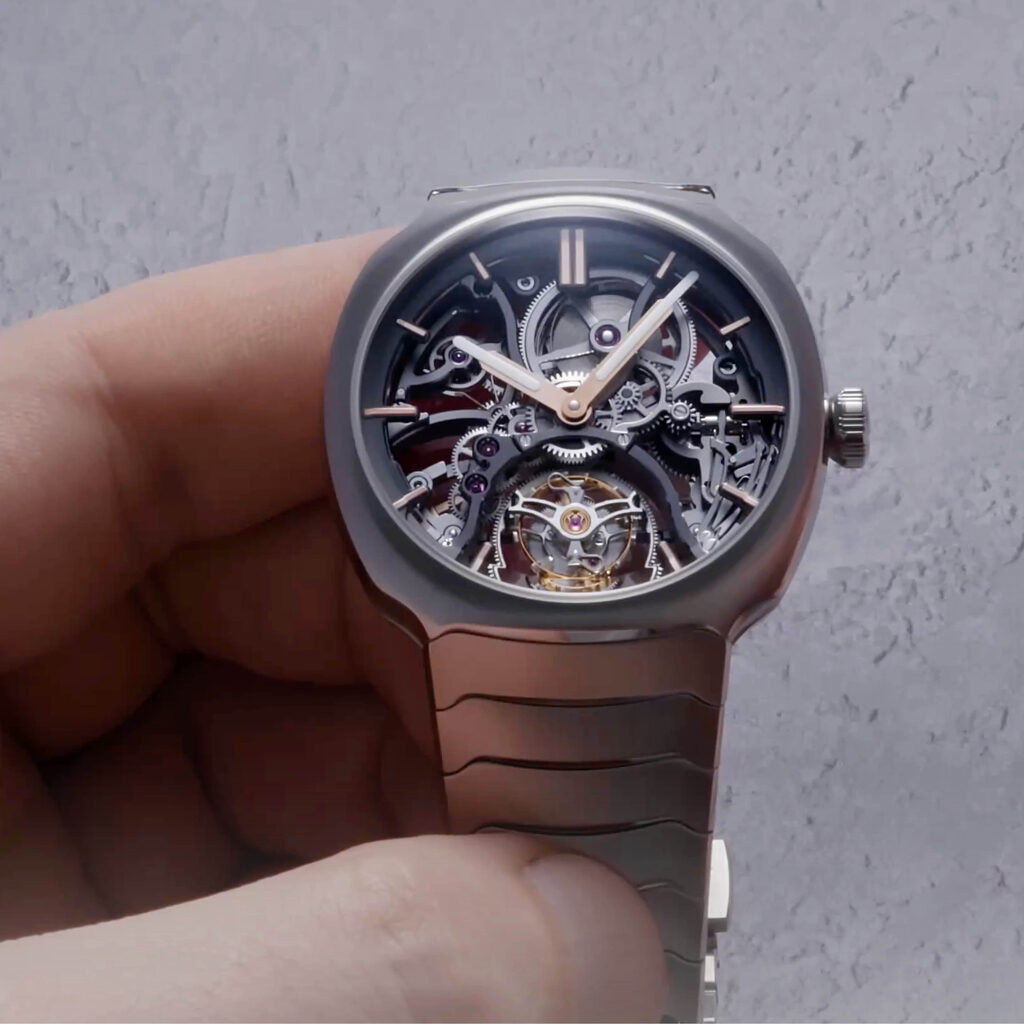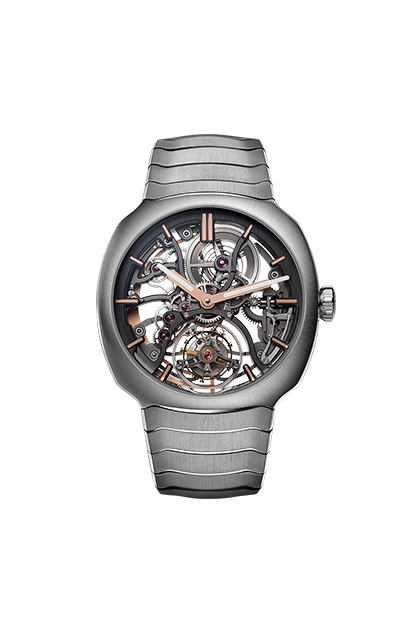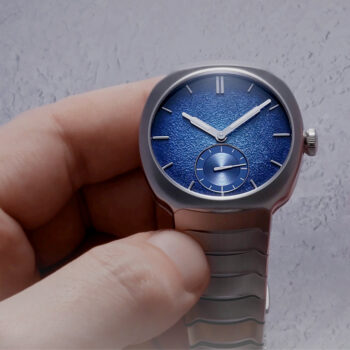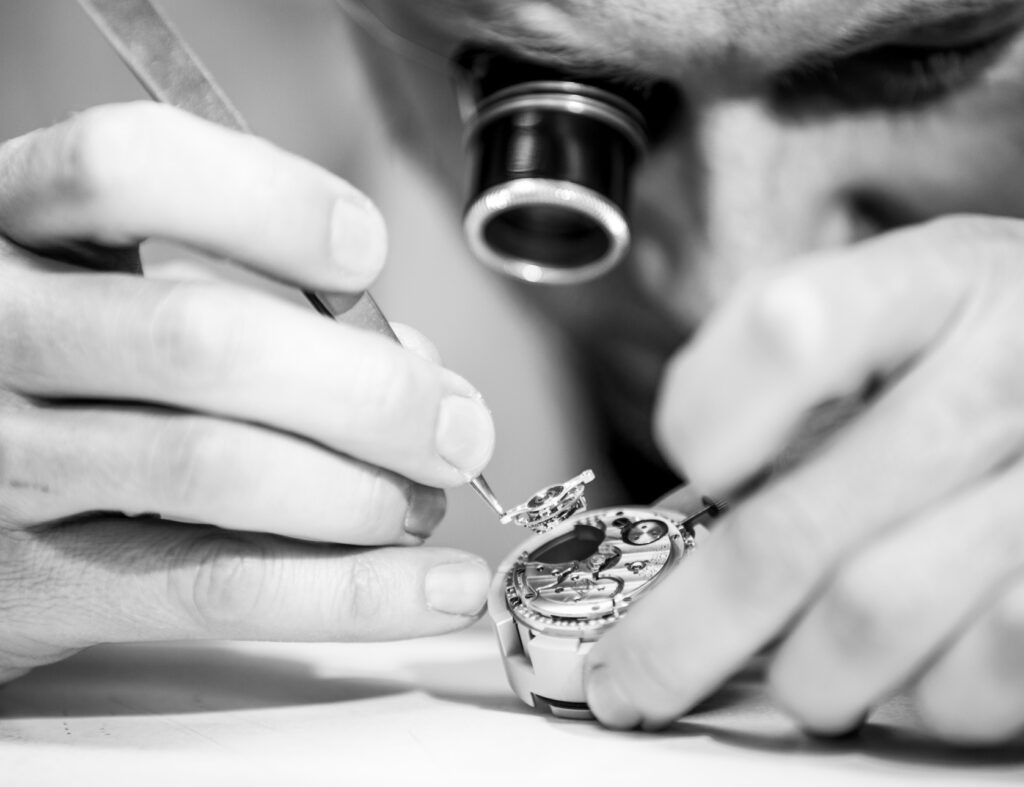A transparent marvel
The 2020 iteration of the Streamliner was made instantly famous by its aerodynamic simplicity, using smooth lines and flowing forms to blend case into bracelet. From the achingly beautiful centre seconds to the delicately poised chronograph, and even the wildly complex perpetual calendar, Moser’s designs have always had this knack of bringing simplicity to complexity. And the Streamliner Tourbillon Skeleton takes this philosophy a step further with its minimalist aesthetic and impeccable symmetry.
While the components that power these watches are usually tucked behind a gleaming dial, there’s no such modesty with the Streamliner Tourbillon Skeleton. Here, they’re out on show for all to see. There’s nowhere to hide, and so every single component has to be on its best behaviour.
Every last detail on show
The focal point is of course the tourbillon, which is of the flying variety. It gets the term ‘flying’ because the cage is supported entirely from the underside. That opens up the front to, quite simply, catch your eye. The tourbillon here is completely unobstructed, and they just craft it like this because it looks so visually striking.
From the auto winding system, into the mainspring, down through the gear train and on to the escapement, the watchmakers at H. Moser & Cie. have peeled back as much material as possible to put every last detail on show. The calibre HMC 814 is on full display, with even the keyless works, where the winding and setting take place, revealing a barrage of components.
Thanks to some clever design, the Streamliner Tourbillon Skeleton doesn’t look exceedingly busy on its 42mm, stainless steel case. In fact it manages to stay relatively consistent with the trim and tidy Moser aesthetic. Taking inspiration from the Pioneer Cylindrical Tourbillon Skeleton, the main structure of the calibre HMC 814 features four spidery supports, like the legs of the Streamliner’s scarab beetle-like form. These receive a dark PVD finish.
With each additional layer—and there are many—the shade lightens, grouping components to make the watch effortlessly comprehensible. The most important parts, the wheels, springs and levers, get the lightest colour, making the visual cascade immediately apparent. You’ll even see the mainspring coiled up within the barrel. The balance itself, the heart of the movement and one of the very few in the world to receive an in-house double hairspring, receives a golden hue, elevating its status as the king of this particular castle.
How it all works
When you remove material from, say, a wheel, you reduce its weight and therefore the impact on the movement. But skeletonising a watch serves only one purpose: it looks stunning. But to make something look this remarkable isn’t easy. The calibre must maintain its structural integrity, and that requires incredible precision to make. There’s no hot glueing this one back together if a watchmaker makes a mistake. Even the rotor weight gets skeletonised. Thankfully it’s in gold, so what’s left still has enough mass to keep the watch wound for the full 72 hours.
With all 167 parts on show, each must be considered in its finish equally. There’s no rug to sweep them under, and so whether polished, brushed or frosted, they each gleam like tiny little jewels. Especially the jewels. And if you’re a budding watchmaker looking to learn the ropes of watchmaking, there’s no better watch to see how it all works. Oh, you want me to tell you? Here goes…
When the rotor spins, it walks those two little pawls either side of the wheel top left so no matter which way it goes, that movement can be captured in the mainspring, which then feeds that kinetic energy down along a waterfall of gears which speed up one after the other. Along the way, one of those gears, which turns once per hour, drives the minute hand, which in turn has another gear offset to slow the speed back down for the hour hand.
Meanwhile, at the bottom of that waterfall is the tourbillon, which makes one full rotation every minute — so the escapement within it is neutralised against gravity. Inside the tourbillon is where the magic happens, with three core parts, the balance, palette fork and escape wheel, acting like a mechanical capacitor to regulate the speed of the mainspring’s energy, the outcome six equally spaced ticks per second, every second. And breathe…
As tough as any Streamliner
Seeing all of these intricate components on display might make this watch feel quite delicate, but this is a Streamliner, so you can take it anywhere. It’s just as capable as every other watch in the collection. There’s 120m of water resistance, so you can probably take your Streamliner Tourbillon Skeleton scuba diving if you’re so inclined.
It really is possible to have it all, so long as by ‘all’, we mean a Streamliner with a tourbillon movement skeletonised to look really cool, because that’s what H. Moser & Cie. have done here. It says so on the label. By combining rugged usability and exquisite intricacy, it begs the question: why wear something boring when you could be wearing this instead?








